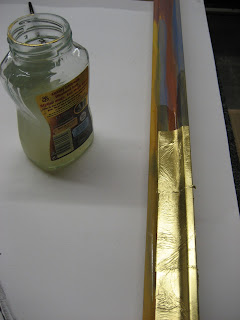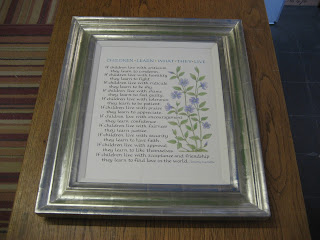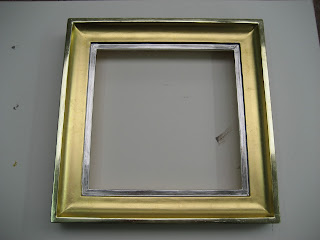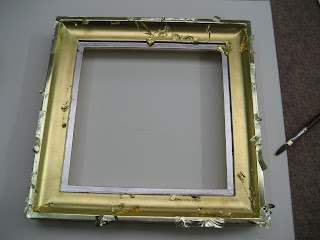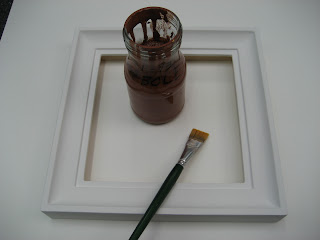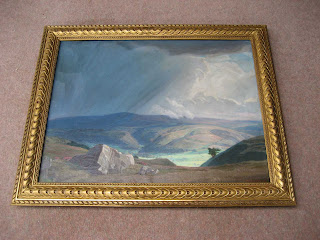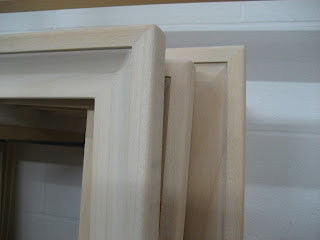Monday
Lean on Me by Nel Whatmore
Another of my favourites from the frame archives. Water gilded 23.5ct gold leaf over multi coloured bole, inner mount with pigment colours, green gold line, gesso wooden slip, and a double mount. Glazed with anti-reflective glass. I love the effect of the coloured bole under the leaf. The print is by Nel Whatmore.
Labels:
water gilded,
water gilding
Sunday
Children Learn What They Live by Dorothy Law Nolte
Water gilded 12 ct white gold over blue and green bole, with glass between gesso bevel slip and the frame, gilding sealed with acrylic varnish.
Labels:
water gilded,
white gold
Making a gilded frame - Distress and finish
The sides of the frame are painted with acrylic primer undercoat, and then a grey emulsion. The frame is then given a distress with 0000 wire wool, to show the bole colour under the leaf. Finally the whole frame is given a protective spray coat of Lascaux UV Protect. I think I actually prefer the finish before the distressing, or maybe I just went in a little hard with the wire wool.
Labels:
water gilded,
water gilding
Making a gilded frame - laying the gold leaf
The frame can now be water gilded, the bole is wetted with a weak mixture of glue, water and IPA alcohol, the gold leaf is then picked up from a gilder's cushion using a brush called a tip and brought into contact with the wetted area, the gold is pulled of the tip by the water. As the water dries the leaf can be pressed firmly into contact with the bole. This sample frame has been gilded with palladium on the sight edge, 23.5ct gold leaf on the scoop, and 18ct green gold on the outer section. Once the initial gilding has taken place any breaks or overlaps between the different types of leaf are filled in, this can be seen in the last photo. The outer section was also burnished lightly with an agate stone burnisher.
Labels:
gilding,
water gilded
Making a gilded frame - The bole
After the gesso has dried it can be sanded smooth, for this I use aluminium oxide paper in 280, 400, and 800 grit. If very little sanding is needed then the gesso can be smoothed with damp cloths. Usually on a frame that is being gilded and painted, the areas not being gilded are only given a quick rub over, as the texture from the brushing or spraying of the gesso can add to the paint effect. I would also only usually apply bole to the areas being gilded.
Bole is very fine clay that is mixed with rabbit skin glue. The most often used colour is red, although it comes in various other colours, that can be mixed to get various shades. The colour of the bole will have a subtle effect on the perceived colour and warmth of the gold leaf, also some boles will burnish better than others.
Sometimes the bole can be burnished before the leaf is laid, this can be done with a stiff brush, a cloth, or an agate burnisher and has an effect on the appearance of finished gilding.
Bole can be bought in dry or wet form, I use wet bole which is mixed with rabbit skin glue (varies from 1:13 to 1:15 strength glue/water), the approximate bole to glue size mix is 1 part bole to 2 or 3 parts glue size, although this is really only a rough guide. The bole is added to the size a little at a time, using a clean spoon or knife each time you take more bole, to ensure no size gets into the bole storage container.
Once the desired consistency is reached the mixture can be strained or filtered to get rid of any lumps. The bole is brushed on the frame, and the number of coats usually varies from 4 to 6. Each coat is applied when the previous coat has dried matt or enough so there are no glossy/wet areas, but as with the gesso, the surface should not be allowed to dry fully before the next coat is applied.
Labels:
bole,
water gilded
Saturday
Cutting down a frame
This 19th Century frame has been cut down to fit a mid 20th Century painting. Some may view the cutting down of antique frames to fit later paintings a small crime, but it has been going on for hundreds of years amongst museums, artists, and collectors; so I don't feel to guilty about it.
The frame was broken apart and then cut to size on a saw, ensuring that the centre ornament on all four sides were kept exactly in central. The guilloche type pattern met up OK at the four corners, but not perfectly, so it has been decided some mitre straps (or ribbons) would look better, these are going to be added to hide the join.
The frame was made a fraction smaller than the canvas and the rebate was then extended slightly to cover some areas of unfinished canvas. The rebate was lined with aluminium barrier tape, this tape serves two purposes;
First, to isolate from the painting any impurities in the wood of the frame. Second, to keep out any dust from the routering of the rebate, as the painting is glazed, it makes to so much easier to keep any loose specks from getting inside during assembly, if the rebate is sealed.
Next some rebate foam is added, this is usually used to cushion a painting from the rebate, but here it just helps to cushion the glazing as the rebates on antique frames often have irregularities. Once the glass was cleaned and put in the frame, a 5mm spacer was added to provide the important air-gap between glass and painting, rebate foam was also put on the spacer to protect the canvas. The glass used was Artglass™, which has high clarity, with minimal reflections.
Sometimes the back of canvases are taped over with gummed brown tape, personally I'm not a fan of this method, and have never been happy with putting water activated adhesive on canvases. The final job was to put some protective clear polyester film over the makers labels on the back of the frame and canvas stretchers, to preserve them for the future.
Labels:
antique frame
Thursday
Lots of frames in production
Here I am spraying gesso on lots of frames, I would quite like to build a large drying rack one day soon, similar to the small shelf unit in the photos that I use as a rack for small frames. So much space is taking up with drying frames, I think a large drying rack next to the spray booth would be a good use of space.
Labels:
gesso,
spray booth
Tuesday
Glue in jars
Here are lots of jars with rabbit skin glue granules soaking in water, this will be used to make gesso over the next few days.
Sunday
Friday
Holding the corners together
The corners on most frames are joined with small metal wedges or V-Nails which come in various sizes. This rather wide moulding also has a dovetail key fitted which will add to the strength of the joint. This particular profile is really quite tricky to work with, but it is very popular with my customers, and I will be framing several paintings with it in the coming weeks.
A simple gilded frame
This frame is water gilded on yellow bole. There is no burnishing as it is intended to be a simple, matt finish. The look is quite understated, but I think it still stands out as being hand made, when compared to the endless factory finished gold frames available.
Labels:
gilding,
water gilded
more stacked frames
Here are lots more frames that have been made up from two mouldings, lots of work goes into the preparation before any of the gesso, bole, and gilding takes place. I always found it interesting how it's the stages you can't see that dictate how good the actual final finish will be.
Stacked mouldings
These two mouldings have been joined together to make a frame for a large painting on board. The inner flat moulding had the outer hollow part cut off, and the outer box frame had the depth decreased by about 25mm, these slight modifications were done on a table saw. The two frames are then glued together, and the join between the frames is filled with a gesso putty, which I make from PVA glue, water, and whiting. The whole frame is now ready to be sanded and then the gilding process will begin.
Tuesday
Cutting and joining
The whole day has been spent cutting and joining frames, tomorrow will be the same. These are for various orders, some frames have a slip and an outer frame, while many are having a slip, a flat or scoop shaped middle frame, and an outer box frame.
I have lost count, but we must have made around 90 frames today, and there are about 70 more to make tomorrow. The workshop layout was moved around a little at the weekend, and I seem to have managed to make better use of the space. Admittedly we are lucky to have plenty of room, but I'm still keen to make the most of the layout and to make each process involved in making frames as efficient as possible.
Friday
Spray booth is up at last!
We finally got round to putting up the spray booth today, its only taken 6 months, and it was in storage for 18 months before that, so it's good to get it in position. There is still the small task of drilling a 16" hole through the back wall, attaching the extraction fan, and fitting the ducting, but hey, one step at a time.
There are still a lot of jobs on the 'to-do list', since moving in 6 months ago, and it has been quite a challenge balancing these jobs around the workshop with getting customers work done.
I have something like 70 gilded frames to make over the next 6 to 8 weeks, so at least now the booth is in position I can have a contained area to spray gesso onto frames, which will greatly increase productivity.
Labels:
gesso,
spray booth
Moulding delivery
We had a large delivery of mouldings today, 11 bundles in all, for various jobs, from orders for just a single frame, up to 26 frames for one exhibition and 37 frames for another. We will be very busy over the coming weeks and months. The moulding above will form the outer part of a frame, and will be gilded.
Making a gilded frame - Mixing up the gesso
The next stage in making our gilded frame is to mix up and apply the gesso. As with the size coat, rabbit skin glue is mixed with water, this time the ratio is 1:10 (1 part glue to 10 parts water). The glue/water is left to soak for 24 hours and is then heated gently in a double boiler. Once it is all melted and warmed the glue is taken off the heat and whiting (calcium carbonate) that has been sieved is added to the glue. I use a spoon to carefully add the whiting to the glue. Usually I use a large metal saucepan, but using a large coffee jar illustrates how the whiting drops to the bottom and absorbs the glue, whiting is added until there is just a small amount of glue left on the surface, basically until no more whiting can be absorbed. Gypsum (calcium sulphate) and some other less common chalks can be used instead of whiting. In times past whiting was mainly used in Northern Europe, while gypsum was favoured in Italy and the south.
This glue and whiting is left for a while before being given a good stir, a few good taps on the jar or container can help eliminate some air bubbles. Some people would now sieve or filter the gesso to remove any last lumps, and sometimes people add other ingredients such as linseed oil, tallow, and alcohol. I have also heard of garlic, salt, and other additives being used, which alter the properties of the gesso.
The rabbit skin glue we use nowadays is a slightly different, modern version of the traditional hide glues used centuries ago, parchment clippings can also be used and is probably a more traditional ingredient, just not that convenient to use. Some relatively new and valid types of gessos are made from PVA adhesive or conservation adhesives such as Paraloid B72. I think the study of gesso is actually quite complex, and I only wish I had time to experiment more with different recipes and types.
So once the gesso is mixed it can be brushed onto the frame, the next coat is applied when the surface has dried and is no longer glossy, apply the next coat to soon and you can get nasty cracks, although you should not wait until the surface is 'white' dry. Timing is key.
The number of coats depends on the quality and type of finish your aiming for, but we usually apply 6 to 8 coats. The gesso can be brushed on or sprayed, if I am spraying I always brush on the first one or two coats and then spray on the final coats, I find the finish is just better doing it this way.
We aim to complete gessoing a frame in a day, doing half one day and the rest the next is never good, as the time between applying each layer is important to building a strong bond between each coat. Another thing to remember is not to overheat the gesso, to much heat breaks the glue down and putting warm gesso on a layer that is cold and dry will result in lots of air bubbles in the finished surface. Once the gessoing is finished the frame is left to dry for at least 12 hours before the next stage, which is the sanding.
Thursday
Assortment of frames and paintings
Various interesting frames and paintings that are either awaiting collection, or have just come in to the workshop and are waiting to be photographed, measured, and put away in the storage racks or plan chests.








